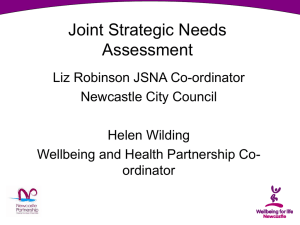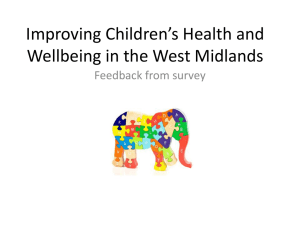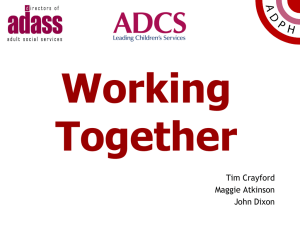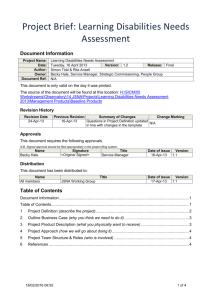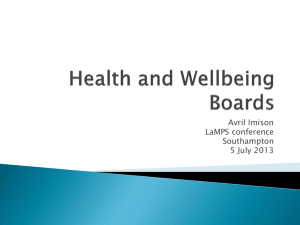ITEM NO.5 AND CHILDREN’S SERVICES
advertisement
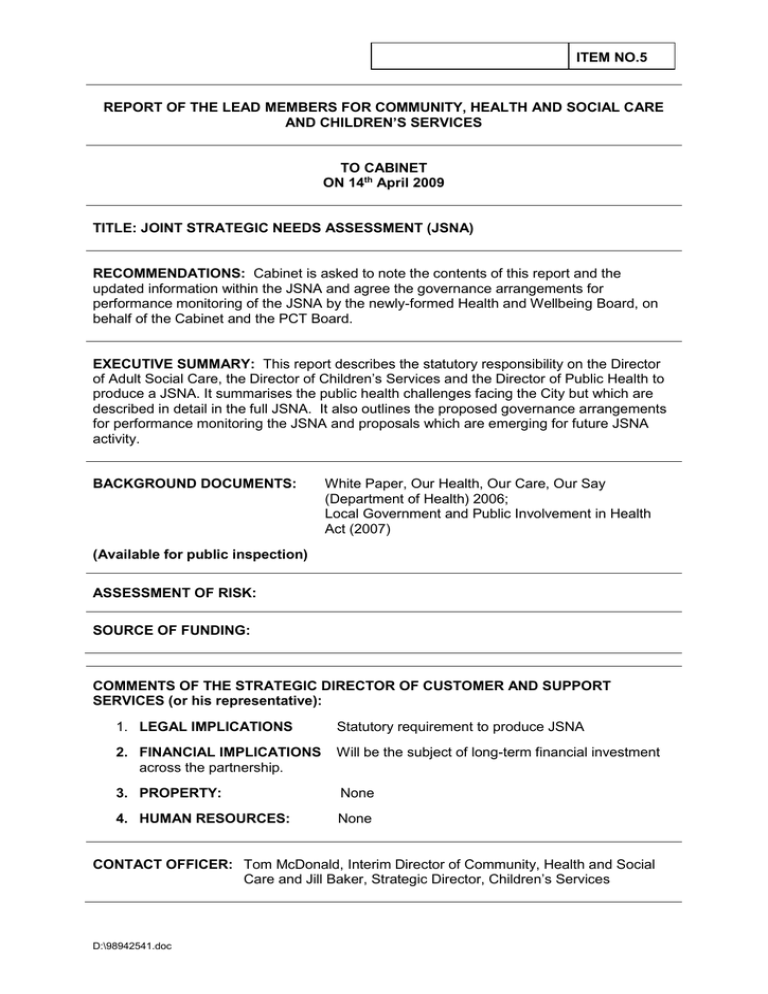
ITEM NO.5 REPORT OF THE LEAD MEMBERS FOR COMMUNITY, HEALTH AND SOCIAL CARE AND CHILDREN’S SERVICES TO CABINET ON 14th April 2009 TITLE: JOINT STRATEGIC NEEDS ASSESSMENT (JSNA) RECOMMENDATIONS: Cabinet is asked to note the contents of this report and the updated information within the JSNA and agree the governance arrangements for performance monitoring of the JSNA by the newly-formed Health and Wellbeing Board, on behalf of the Cabinet and the PCT Board. EXECUTIVE SUMMARY: This report describes the statutory responsibility on the Director of Adult Social Care, the Director of Children’s Services and the Director of Public Health to produce a JSNA. It summarises the public health challenges facing the City but which are described in detail in the full JSNA. It also outlines the proposed governance arrangements for performance monitoring the JSNA and proposals which are emerging for future JSNA activity. BACKGROUND DOCUMENTS: White Paper, Our Health, Our Care, Our Say (Department of Health) 2006; Local Government and Public Involvement in Health Act (2007) (Available for public inspection) ASSESSMENT OF RISK: SOURCE OF FUNDING: COMMENTS OF THE STRATEGIC DIRECTOR OF CUSTOMER AND SUPPORT SERVICES (or his representative): 1. LEGAL IMPLICATIONS Statutory requirement to produce JSNA 2. FINANCIAL IMPLICATIONS across the partnership. Will be the subject of long-term financial investment 3. PROPERTY: None 4. HUMAN RESOURCES: None CONTACT OFFICER: Tom McDonald, Interim Director of Community, Health and Social Care and Jill Baker, Strategic Director, Children’s Services D:\98942541.doc WARD(S) TO WHICH REPORT RELATE(S): All KEY COUNCIL POLICIES: Corporate Plan 1. INTRODUCTION In 2006, the Department of Health (DH) White Paper Our health, our care, our say set out a new direction for improving the health and wellbeing of the population particularly to improve prevention and early intervention, improve choice and enhanced access to services, create a stronger voice for individuals and communities, provide more support for people with long term needs and tackle health inequalities. The White Paper identified the need for Directors of Public Health, Adult Social Services and Children’s Services to undertake regular Joint Strategic Needs Assessment (JSNA) of the health and wellbeing status of their populations, enabling local services to plan, through Local Area Agreements (LAA), both short and medium term objectives. In reality, the framework is an 8 strand action plan, with the 8 strands being the ‘standards’ that the DH expects from commissioners of health & wellbeing services. The strands are: Putting people at the centre of commissioning; Understanding the needs of populations; Sharing and using information more efficiently; Assuring high quality providers for all services; Recognising the interdependence between work, health & wellbeing; Developing incentives for commissioning for health and wellbeing; Making it happen – local accountability; and Making it happen – capability and leadership. Whilst this framework is issued by the DH and targeted towards PCT’s and social care services, this has much wider implications for local government as a whole in terms of the wider wellbeing agenda for other directorates and to pick up the links between this work and the Salford Strategic Partnership (SSP) and the LAA. JSNA is the means by which the local authority and the PCT will describe the future health, care and well-being needs of local populations and the strategic direction of service delivery to meet those needs. JSNA’s form the basis of a new duty to co-operate for PCT’s and local authorities that is contained in the Local Government and Public Involvement in Health Bill. JSNA’s take account of data and information on inequalities between the differing, and overlapping, communities in local areas and support the meeting of statutory requirements in relation to equality audits. The JSNA is seen as a way for local leaders and decision-makers to develop an improved shared understanding of the health and social care needs of their local population, a joint vision and an integrated approach to improving health and well-being, reducing inequalities and promoting health equity. Health and local authority commissioners could have a greater overall impact if they planned from a shared data set with common understanding of their local population’s needs, delivering agreed measured outcomes and reporting progress against them to those whose needs have been assessed. The JSNA is a public document and should be reproduced in line with the LAA, i.e.: every 3 years. D:\98942541.doc According to the DH, good JSNA’s will: Provide analyses of data to show the health and well-being status of local communities; Define where inequities exist; Use local community views and evidence of effectiveness of interventions to shape the future investment and disinvestment services; Define achievable improvements in health and well-being outcomes for the local community; Send signals to existing and potential providers of services about potential service change; Support the delivery of better health and well-being outcomes for the local community; Inform the next stages of the commissioning cycle; Aid better decision-making; and Underpin the LAA and the choice of local outcomes and targets, as well as the PCT’s own prospectus. The Local Government and Public Involvement in Health Act (2007) which followed the White Paper, places a duty on local authorities to prepare (in consultation with others) LAA, and a joint duty on local authorities and PCT’ to produce a JSNA. The draft statutory guidance accompanying the Act positions JSNA as underpinning the Sustainable Community Strategy and, in turn, the LAA. In the guidance JSNA is defined as: A systematic method for reviewing the health and wellbeing needs of a population, leading to agreed commissioning priorities that will improve health and wellbeing outcomes and reduce inequalities. What is a Joint Strategic Needs Assessment? Joint Strategic Needs Assessment (JSNA) is the means by which Primary Care Trusts (PCT’s) and Local Authorities (LA’s) will describe the future health, social well-being and housing needs of local populations and the strategic direction of service delivery to meet those needs JSNA’s form the basis of a new duty to co-operate for PCT’s and local authorities that is contained in the current Local Government and Public Involvement in Health Bill JSNA’s will take account of data and information on inequalities between the differing, and overlapping, communities in local areas and support the meeting of statutory requirements in relation to equality audits. Why do a JSNA? The reason for doing a JSNA, and doing it well, is to develop the whole health, well-being, social care and housing response so it more closely meets the wants and needs of local people. It will provide an opportunity to look ahead three to five years and support and direct the change that needs to happen in local service systems so that: services are shaped by local communities; inequalities are reduced; social inclusion is increased; these outcomes are maximised at minimum cost. D:\98942541.doc The JSNA should support: An improved understanding the current and future health and wellbeing needs of the population; over both the short term (three to five years) to inform LAA, and the longer term future (five to ten years) to inform strategic planning; Commissioning of services and interventions that will achieve better health and wellbeing outcomes and reduce inequalities. In particular, JSNA will address those outcomes described in both the National Indicator Set for local authorities and local authority partnerships, and the “vital signs” referred to in The NHS in England: The Operating Framework for 2008/09. 2. THE 2007/08 JSNA The 2007 JSNA, produced jointly by Anne Williams, Strategic Director of Community Health and Social Care, Jill Baker, Strategic Director of Children’s Services and Dr Julie Higgins, Director of Public Health and Deputy Chief Executive, Salford PCT, is the first such attempt to produce an all encompassing picture of the health challenges across Salford with detailed recommendations. It provides an insight both to the health challenges which Partners In Salford face, but also to the future potential for the JSNA process. The key recommendations from the first JSNA together with the responsible bodies identified for their delivery can be found in the executive summary at the beginning of the document which is available on the PCT internet: http://www.salford-pct.nhs.uk/documents/JointStrategicNeedsAssessment.pdf and the Salford Observatory: http://www.salford.gov.uk/living/health/planning-socialcare/kloa-selfassessment-0708/chsc-commissioninganduseofresourcesoutcome9-07-08.htm A presentation summarising the findings is attached in Appendix 1. Distribution and dissemination of its findings to the relevant groups identified in this list are now currently taking place. Key priorities from within the 2007/8 JSNA are: Issues Circulatory Disease Cancer Respiratory Disease Smoking Alcohol Salford situation Overall a 37% higher rate than the national. Lung cancer SMR’s1 of 180 for men and 214 for women High levels linked to our future long term conditions demand Biggest killer 46,170 smokers >16 years Cost to local economy in the region of £54M/year. SMR’s for alcohol related deaths Invest in treatment and specifically are: invest in tier 2 brief interventions in Male 199 Primary Care. Female 155 Contribution to poor health, health inequalities rising. High alcohol admission rates for children. 1 Prevention /reduction approaches Reduce smoking rates, find unidentified hypertensives. Reduce smoking rates and improve early identification and intervention. Reduce smoking levels and identify people with COPD early. Invest in interventions that reduce smoking rates. Invest in specific interventions for young people. Standard Mortality Ratios (SMR) are used to compare death rates in an area with a standard population (accounting for age and sex structure) - usually the population of England or regional population. For example, if an area has an SMR of 120 it has a mortality rate 20% higher than the regional average after accounting for differences in the age structure of each population. D:\98942541.doc Issues Mental Health Obesity Salford situation More mentally ill people on incapacity benefits than unemployed people on Jobseeker’s Allowance. Prevention /reduction approaches Invest in early interventions to keep people in work – improve possibilities of people with mental health conditions getting back into work. Currently nearly 21,000 people in Salford being treated for depression. Salford has: 39,000 obese adults 68,000 overweight. Roll out of psychological therapies and stepped care model for treatment of depression. Invest in the healthy weight maintenance through the obesity care pathway. 5,500 Obese Children 5,700 Overweight. Partners to invest in interventions to enable people to maintain a healthy weight. Cost to local economy in the region of £10m a year. Children and young people 1. Reduce the number of children who are looked after, by providing more multi-disciplinary, early intervention services for vulnerable children and their families and achieving permanence for those who are looked after. 2. Improve our safeguarding arrangements. 3. Close the gap in attendance, exclusion and attainment, especially at KS3 and KS4. 4. Increase the number of children and young people engaged in healthy physical and emotional lifestyles. 5.Increase the number of children and young people engaged in safe behaviour and reduce obesity, teenage conceptions, sexually transmitted diseases, the use of alcohol and substance misuse. 6. Increase the number of children and young people participating in decision making and supporting their communities. 7. Extend the number of young people engaged in further education, training and employment. D:\98942541.doc Influence partners to enable Salford to be a ‘walking city’ with fewer fast food outlets. Use the commissioning process to improve services and outcomes. Align services and interventions to all children and young people but especially vulnerable children, young people and families. Invest in inclusive excellent universal services and integrated early intervention services. Develop 21st century schools through BSF and the Primary Capital Programme. 3. FUTURE CHALLENGES FOR THE JSNA Key issues which arise from the first round of JSNA can be summarised in two areas: Governance arrangements: o It is proposed that the Healthy City Executive in its new form – Health and Wellbeing Board, will performance monitor delivery against the recommendations. Access to JSNA findings and integration of the findings into the work of all Partners in Salford: o o The current JSNA document is an excellent first step but it is acknowledged that there is a need to improve access to the JSNA data, widen participation in the JSNA process and integrate it into the planning cycle for partnership boards and LAA structures. The logical portal for addressing these issues is the developing Salford Observatory. A presentation of the JSNA at the August Strategic Partnership Executive meeting was received with enthusiasm and precipitated a discussion about aligning analytical processes across partner agencies and the need to rapidly establish an intelligence community to underpin both the JSNA process and other tactical documents like the strategic threat assessment for the Crime and Disorder Reduction Partnership. An initial meeting has taken place to explore how to align the JSNA processes with the development of the Observatory and will consider the development of the intelligence community. 4. RECOMMENDATIONS The Cabinet is asked to: Note the contents of this report and the updated information.. Agree the governance arrangements outlined whereby the newly-formed Health and Wellbeing Board performance monitor the JSNA on behalf of the Cabinet and the PCT Board. D:\98942541.doc
